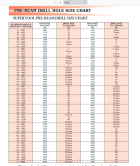butchlambert
Site $$ Sponsor
How much do I need to leave before reaming? Maybe 015" under reamer size. Holes will be .200 to .500.
Follow along with the video below to see how to install our site as a web app on your home screen.
Note: This feature may not be available in some browsers.
About what I thought. ThanksHere's what I'd shoot for Butch. .010" for under .250" and .015" for .250"-.500"
I looked in my 1959 issue of the Machinist Handbook, but didn't find it.There is a chart somewhere for this I think? At least I remember something like that back in shop class.
In my shop class, might of been something from the reamer manufactuer. However, it did keep most of us dummies from messing our projects up.I looked in my 1959 issue of the Machinist Handbook, but didn't find it.
Must be, but I never found it. .010-.020 won't hurt me.In my shop class, might of been something from the reamer manufactuer. However, it did keep most of us dummies from messing our projects up.
Shop teacher: "check the chart" was a fav quote. There were quite a few charts in the room that answered all kinds of questions. So now, when ever I have a question like this I think to my self "I bet there is a chart for that"

Two factors really...don't overload the flutes with chips but also, leave enough material that the reamer has to actually cut rather than rub tight. The 3% rule I posted earlier came from when I did tool and die work full time. That stuck with me for all these years and has never let me down. But yeah, there's almost certainly a chart somewhere, too. You can get by with more and less with different reamers and materials, Really, as much as we scrutinize everything in the gun business, a chamber reamer is probably the hardest reamer to get just right of any but yet, some pre-drill/bore and some use a finish reamer from start to finish with good results both ways. Hole depth is another factor and it seems like there was a rule regarding that too but I don't remember that one. Lol! 3% rule covers a lot of ground though.Must be, but I never found it. .010-.020 won't hurt me.
Thanks for the suggestions.

